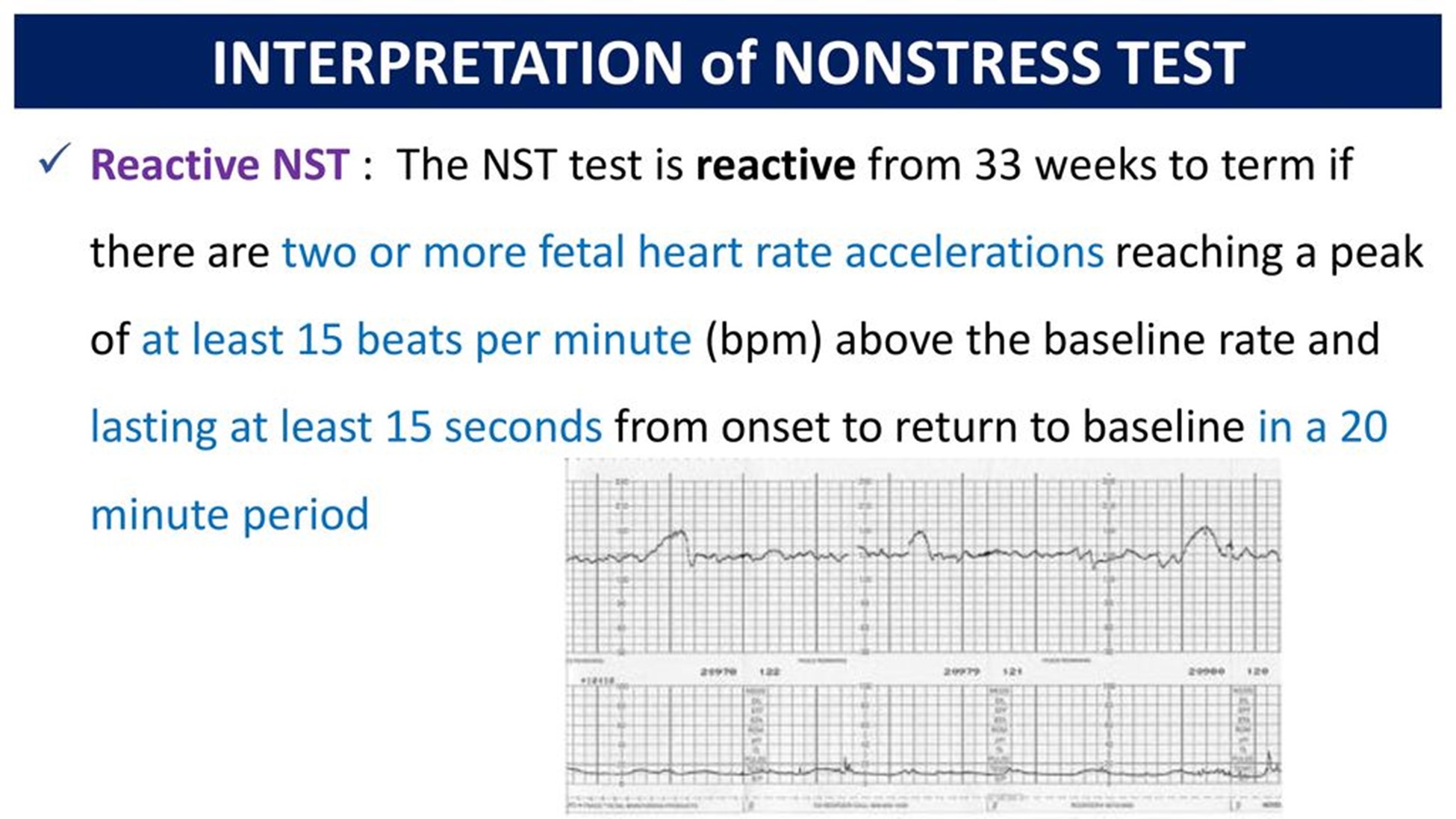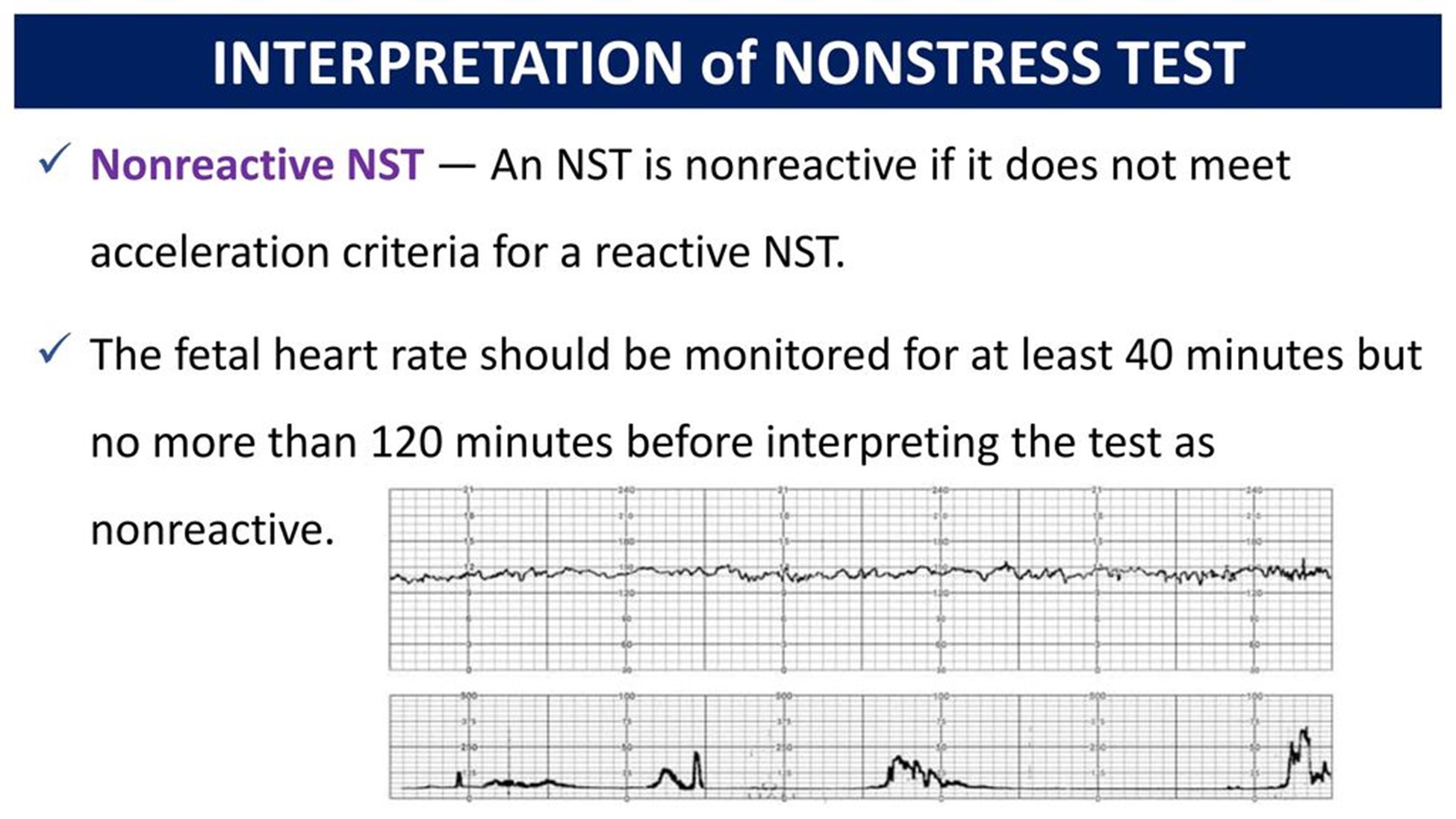A nurse is performing a non-stress test (NST) for a client who is 34 weeks pregnant and has pre-eclampsia.
Which of the following fetal heart rate patterns indicates a reactive test?
Two or more accelerations of at least 15 beats/min above baseline lasting for at least 15 seconds in a 20-minute period
No accelerations or decelerations in a 20-minute period
One acceleration of at least 10 beats/min above baseline lasting for at least 10 seconds in a 20-minute period
Variable decelerations with normal variability in a 20-minute period
The Correct Answer is A
Two or more accelerations of at least 15 beats/min above baseline lasting for at least 15 seconds in a 20-minute period. This indicates a reactive test, which means that the fetus is well oxygenated and not in distress.

Choice B is wrong because no accelerations or decelerations in a 20-minute period indicate a non-reactive test, which may suggest fetal hypoxia or acidosis.
Choice C is wrong because one acceleration of at least 10 beats/min above baseline lasting for at least 10 seconds in a 20-minute period is the criterion for a reactive test for gestational age less than 32 weeks, not 34 weeks.
Choice D is wrong because variable decelerations with normal variability in a 20-minute period indicate cord compression or fetal head compression, not a reactive test.

Nursing Test Bank
Naxlex Comprehensive Predictor Exams
Related Questions
Correct Answer is D
Explanation
Protein excretion of 450 mg indicates proteinuria.Proteinuria is the presence of excess protein in the urine, which can be a sign of kidney damage or disease.Normal protein excretion in a 24-hour urine collection is less than 150 mg.
Choice A is wrong because protein excretion of 150 mg is within the normal range.
Choice B is wrong because protein excretion of 250 mg is slightly above the normal range, but not enough to indicate proteinuria.
Choice C is wrong because protein excretion of 350 mg is also above the normal range, but not enough to indicate proteinuria.
Preeclampsia is a condition that affects some pregnant women, usually after 20 weeks of pregnancy.It causes high blood pressure and proteinuria, which can harm both the mother and the baby.A 24-hour urine collection is a simple lab test that measures what’s in the urine and checks kidney function.The test is done by collecting all the urine passed in a 24-hour period in a special container that must be kept cool until returned to the lab.
Correct Answer is C
Explanation
“This medication will help my baby’s lungs develop faster.” Corticosteroid therapy is given to pregnant clients with eclampsia to accelerate fetal lung maturity and reduce the risk of respiratory distress syndrome in the newborn.
Some possible explanations for the other choices are:
• Choice A is wrong because corticosteroids do not lower blood pressure.Antihypertensive drugs such as hydralazine or labetalol are used to treat hypertension in eclampsia.
• Choice B is wrong because corticosteroids do not prevent seizures.Magnesium sulfate is the drug of choice for seizure prophylaxis and treatment in eclampsia.
• Choice D is wrong because corticosteroids do not reduce inflammation in the body.They may have anti-inflammatory effects in some conditions, but their main purpose in eclampsia is to enhance fetal lung development.
Normal ranges for blood pressure and proteinuria in pregnancy are:
• Blood pressure: less than 140/90 mm Hg
• Proteinuria: less than 300 mg/24 hours or less than 1+ on dipstick
Whether you are a student looking to ace your exams or a practicing nurse seeking to enhance your expertise , our nursing education contents will empower you with the confidence and competence to make a difference in the lives of patients and become a respected leader in the healthcare field.
Visit Naxlex, invest in your future and unlock endless possibilities with our unparalleled nursing education contents today
Report Wrong Answer on the Current Question
Do you disagree with the answer? If yes, what is your expected answer? Explain.
Kindly be descriptive with the issue you are facing.
